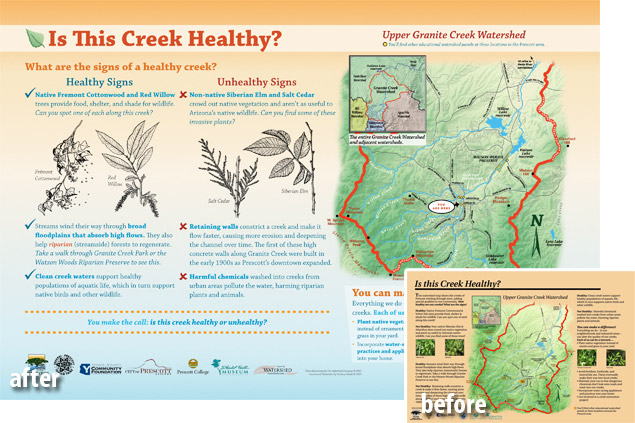Written by Watershed Staff
Yes, the 80’s are back, but that doesn’t mean interpretive signs from 1985 are cool again too. Material improvements help interpretive signs last longer, but the graphic and content lifespan is 10 years at most.
But why replace an interpretive sign that isn’t physically worn out yet?
Watershed provided an updated visual look and illustration style for several signs at the Haselwood YMCA for Kitsap County.
Science Improves
Scientists continue to refine our understanding of natural systems. You wouldn’t want your kids reading a textbook fifteen years old! Why would your visitors want to read an interpretive sign that old? Keep your information up to date with today’s best available science.
Your Visitors are Different
Your audience now is different from your audience twenty years ago, even if the demographics still match. It’s a whole new generation. Today’s visitors may know more or less about your topic to start with. Different metaphors or methods of explanation might resonate better with their perspective. Existing interpretive themes can be adapted to better suit today’s audience.
You’ve Polished Your Message
You’ve probably refined your mission statement over the past ten years. Elaborate your new vision with your interpretive content so all your visitors get the benefit of those years of improvement.
Style Changes.
We updated the style and layout of an existing interpretive sign for the organization Prescott Creeks in Arizona.
Style is often associated with an era. Think of 1970s houses – orange shag carpet, avocado appliances… Interpretive signs can also look out of date. Graphics are an essential component of interpretive signs. Update your signs to visually appeal to today’s audience. We often create interpretive graphics using digital vector illustrations, which look clean and modern.
Your Site is Not Static
What’s changed in the past twenty years at your site? How about the last ten? There’s nothing more frustrating than reading an interpretive sign that seems to have no relation to its location. Natural areas change constantly – flooding and fires are dramatic roots of change, but even growing plants may transform a meadow to a forest. Site plans change too –you might have added on to your trail, developed a new area, or implemented a restoration plan. Take advantage of opportunities to match your interpretation to your site as it exists today.
Technology Changes
Digital devices and connectivity are now essential aspects of people’s daily lives. Engage today’s audiences by using today’s technology. Reference your group’s website – or, better yet, add a QR code that visitors can scan with their smartphone. QR codes could direct visitors to webpages with a deeper level of information, play audio tours, or show videos. Geolocation opens fun opportunities – send people to a digital map of the area with points of interest marked. You could even suggest a hashtag for tweeters and instagrammers! Enhance visitors’ ability to connect and learn by using the technology of their everyday lives.
Attitudes Change
Signs from the past practically begged people to “make a difference.” Today, sustainable living is popular, and people are interested in how they can reduce their impact while maintaining their same standard of living. Ride the sustainability zeitgeist with your signs, and help make an impact outside of your site.
Updated interpretive sign for Scott County in Minnesota.
Looking to update your interpretive signs?
We love to help clients reimagine and develop new interpretive content.
Give us a call if you need a hand!









